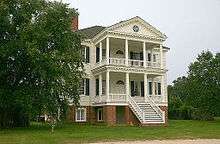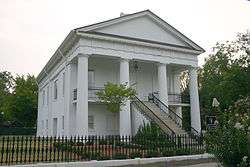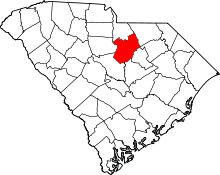Camden, South Carolina
| Camden, South Carolina | |
|---|---|
|
Original Kershaw County courthouse in Camden | |
| Nickname(s): Steeplechase Capital of the World | |
| Motto: Classically Carolina | |
|
| |
| Coordinates: 34°15′33″N 80°36′33″W / 34.25917°N 80.60917°WCoordinates: 34°15′33″N 80°36′33″W / 34.25917°N 80.60917°W | |
| Country | United States |
| State | South Carolina |
| County | Kershaw |
| Founded | March 22, 1786 |
| Government | |
| • Type | City Manager-Council |
| • Mayor | Alfred Mae Drakeford |
| Area | |
| • Total | 10.68 sq mi (27.7 km2) |
| • Land | 10.07 sq mi (26.1 km2) |
| • Water | 0.61 sq mi (0.3 km2) 5.71% |
| Elevation | 187 ft (57 m) |
| Population (2016) | |
| • Total | 7,126 |
| • Density | 724.8/sq mi (280.8/km2) |
| Time zone | Eastern (UTC-5) |
| • Summer (DST) | Eastern (UTC-4) |
| ZIP codes | 29020, 29021 |
| Area code(s) | 803 |
| FIPS code | 45-10855[1] |
| GNIS feature ID | 1247113[2] |
| Website |
www |
Camden is a city in Kershaw County, South Carolina, United States.[3] It is the largest city and county seat of Kershaw County. The population was 7,126 in the 2016 census.[4] It is part of the Columbia, South Carolina, Metropolitan Statistical Area.
Camden is the oldest inland city in South Carolina, and home to The Carolina Cup and The National Steeplechase Museum.
Geography
According to the United States Census Bureau, Camden has a total area of 10.68 square miles (27.7 km2), of which 10.07 square miles (26.1 km2) is land and 0.61 square miles (1.6 km2) (5.71%) is water.
Camden is located 29 miles north of Sumter, 30 miles northeast of the state capital, Columbia, 150 miles north of Charleston, 118 miles west of Myrtle Beach and 85 miles southeast of Charlotte, North Carolina. It is just to the north of Interstate 20, at the intersection of US 1 and US 521 and 601.
History
Camden is the oldest inland city and fourth oldest city in South Carolina. It is near the center of the Cofitachequi chiefdom that existed in the 1500s.[5] In 1730, Camden became part of a township plan ordered by King George II. Kershaw County’s official web site states, “Originally laid out in 1732 as the town of Fredericksburg in the Wateree River swamp (south of the present town) when King George II ordered eleven inland townships established along South Carolina's rivers, few of the area settlers chose to take lots surveyed in the town, choosing the higher ground to the north. The township soon disappeared.” In 1758, Joseph Kershaw, from Yorkshire, England came into the township, established a store and renamed the town Pine Tree Hill. Camden became the main inland trade center in the colony. Kershaw suggested that the town be renamed Camden, in honor of Lord Camden, a champion of colonial rights in the British Parliament.
May 1780 brought the American Revolution to Charleston, South Carolina, when it fell under the Crown's control. Lord Charles Cornwallis and 2,500 of his Loyalist and British troops marched to Camden and established there the main British supply post for the Southern campaign. The Battle of Camden, the worst American defeat of the Revolution, was fought on August 16, 1780 near Camden, and on April 25, 1781 the Battle of Hobkirk Hill was fought between about 1,400 troops led by General Nathanael Greene and 950 Loyalists and British soldiers led by Lord Francis Rawdon. The latter battle was a costly win for the British, and forced them to leave Camden and retreat to the coast. After the Revolution, Camden's prominence and wealth grew as a major interior trading town with direct ties to Charleston and the world. Regional products, augmented with goods from the interior of North Carolina and far lands to the west were transported from Camden to Charleston on flat-bottom riverboats that plied the adjacent Wateree river before the railroad arrived in 1842.
Camden, although not involved directly with the Civil War, did send six generals who contributed significantly. Richard Rowland Kirkland - 'The Angel of Marye's Heights' - is interred in the Old Quaker Cemetery. At the end of the war, components of Sherman's army burned Confederate and nearby properties including a full block of downtown buildings. The last Federal officer killed in the Civil War died in a skirmish near Camden.
Starting in the mid-1880s the Camden area became an increasingly popular destination for wealthy northern families to spend the winter. Eventually three resort hotels provided state of the art winter tourism activities well into the 1930s and beyond. The town became associated with many equestrian activities, and is now the home of the third oldest active polo field in America. In the winter, more than 1,500 thoroughbreds call the area home. According to Kershaw County’s web site, “Horse related activities became very popular. That interest in equine activities has continued and today the horse industry is a major part of the county economy. For that reason, the county is known as the ‘Steeplechase Capital of the World’.”
Because of its long history and many years of wealthy winter visitors and deep-pocket northern owners, Camden has an enviable inventory of antebellum homes and charm that remains unique among towns of its size in South Carolina and elsewhere.
The Adamson Mounds Site, Belmont Neck Site -38KE06, Bethesda Presbyterian Church, Boykin Mill Complex, Camden Battlefield, Zachariah Cantey House, Carter Hill, City of Camden Historic District, Cool Springs, Thomas English House, Historic Camden Revolutionary War Restoration, Kendall Mill Historic District, McDowell Site, Mulberry Plantation (James and Mary Boykin Chesnut House), and Seaboard Air Line Railway Depot are listed on the National Register of Historic Places.[6]
Demographics
| Historical population | |||
|---|---|---|---|
| Census | Pop. | %± | |
| 1850 | 1,133 | — | |
| 1860 | 1,621 | 43.1% | |
| 1870 | 1,007 | −37.9% | |
| 1880 | 1,780 | 76.8% | |
| 1890 | 3,533 | 98.5% | |
| 1900 | 2,441 | −30.9% | |
| 1910 | 3,569 | 46.2% | |
| 1920 | 3,930 | 10.1% | |
| 1930 | 5,183 | 31.9% | |
| 1940 | 5,747 | 10.9% | |
| 1950 | 6,986 | 21.6% | |
| 1960 | 6,842 | −2.1% | |
| 1970 | 8,532 | 24.7% | |
| 1980 | 7,462 | −12.5% | |
| 1990 | 6,696 | −10.3% | |
| 2000 | 6,682 | −0.2% | |
| 2010 | 6,838 | 2.3% | |
| Est. 2016 | 7,126 | [7] | 4.2% |
| U.S. Decennial Census | |||
As of the census[1] of 2010, there were 6,838 people residing in the city limits, in 2,967 households and 1,800 families. The population density was 692.2 people per square mile (267.4/km²). There were 3,544 housing units at an average density of 331.8 per square mile (127.9/km²). The racial makeup of the city was 62.2% White, 35.1% African American, 0.20% Native American, 0.7% Asian, 0% Pacific Islander, 2.7% from other races, and 1.1% from two or more races. Hispanic or Latino of any race were 2.4% of the population.
There were 2,967 households out of which 27.7% had children under the age of 18 living with them, 41.1% were married couples living together, 16.5% had a female householder with no husband present, and 36.3% were non-families. 35.6% of all households were made up of individuals and 18.9% had someone living alone who was 65 years of age or older. The average household size was 2.26 and the average family size was 2.94.
In the city, the population was spread out with 21.9% under the age of 18, 20.1% from 18 to 39, 34.5% from 40 to 64, 17.3% from 65 to 84, and 4.3% who were 85 years of age or older. The median age was 45.3 years. 45.0% of the population was male and 55.0% of the population was female.

The median income for a household in the city was $48,313, and the median income for a family was $62,140. Males had a median income of $42,597 versus $32,524 for females. The per capita income for the city was $26,385. About 13.7% of families and 15.4% of the population were below the poverty line, including 19.3% of those under age 18 and 13.2% of those age 65 or over.
The Carolina Cup
The Carolina Cup is an annual event held on either the final Saturday in March or the first Saturday of April. The first race was held March 22, 1930 and has been held every year since, with the exception of 1943 and 1945, during World War II. The races have become a South Carolina tradition, and normally draw a crowd of over 70,000 spectators. The "Cup" has become a premier social sporting event. The race is held at the Springdale Race Course, just north of Camden. The National Steeplechase Museum is also located near the track.
Among major steeplechase horse races, it is unique in that South Carolina state law prohibits gambling on horse racing.
Historic landmarks
- Historic Robert Mills Courthouse
- Historic Camden Revolutionary War Site
- Kendall Mill Historic District
- Old Quaker Cemetery
- Camden Battlefield, site of Battle of Camden
- Battle of Hobkirk's Hill
Government
The city's government consists of city manager-council.
Alfred Mae Drakeford was elected as mayor of Camden in November 2016. Camden is represented in the South Carolina Senate by Vincent Sheheen, who was born in Camden. It is part of South Carolina's 5th Congressional District, which is represented by Ralph Norman.
Education
The Kershaw County School District is the governing body of the public schools in the area.
Public schools
- Camden High School
- Applied Technology Education Center (ATEC)
- Camden Middle School
- Camden Elementary School
- Pine Tree Hill Elementary School
- Jackson Elementary School
Private schools
Higher education
Central Carolina Technical College has two branches located in Camden, in downtown and near Exit 98 on I-20.
Economy
Major employers in the area include Haier, Hengst Automotive, Medtronic, Canfor, Duke Energy, Invista, and Kershaw Health.
In early 2017, Camden completed a city project that consisted of installing energy efficient street lights along Exit 98 of the I-20 corridor, making it the only lighted exit on I-20 between Florence and Columbia.
Culture
Camden greatly thrives in it's boasting equine industry, which draws in great tourism for the city. A variety of local and private horse and cattle ranches operate throughout the area. The city is also known for its many antique shops and displays. Camden also supports The Fine Arts Center of Kershaw County, a local fine arts organization that sponsors and supports local talent such as arts and music, as well as live entertainment and performances from celebrity guests. Camden also hosts the Kershaw County Farmers Market, which opens every Saturday in Historic Camden.
Events
The Carolina Downhome Blues Festival is an annual three-day event that takes place every October, which recongnizes famous blues aritsts from around the globe, who perform live in Downtown Camden. The Revolutionary War Field Days takes place during the first week of November, which includes a reenactment of the Revolutionary War, which is performed in the Historic Camden Revolutionary War Site by local reenactors. The Camden Christmas Parade is the first of many Christmas parades that takes place during the season in Kershaw County. The event takes place along Downtown Camden to the city arena. The parade features performances from local dance teams, school bands, and cheerleaders, as well as sponsors from city branches and local businesses that participate in the event.
Transportation
- Seaboard Air Line Railway Depot
- Woodward Field, also known as Kershaw County Airport
Highways
- Interstate 20 is a four lane interstate highway that enters 3 miles south of the city. The highway leads 51 miles east to the city of Florence, 30 miles west to Columbia, then onward 244 miles to Atlanta, Georgia.
- US 1 is a east to west route that leads through the downtown area. The route leads 30 miles west to Columbia, then 55 miles east to the town of Cheraw.
- US 521 is a north to south route that leads through downtown. The highways leads 29 miles to the city of Sumter and 38 miles to the city of Lancaster.
- US 601 is a route that leads 51 miles southwest to St. Matthews, then onward 64 miles to the city of Orangeburg. The route leads northeast 21 miles to the town of Kershaw, then 42 miles to Pageland.
- South Carolina Highway 97 is a state highway that leads north 13 miles to Lake Wateree Recreational Area access, 20 miles to Liberty Hill, onward 34 miles to the city of Great Falls and then 53 miles to the town of Chester.
- South Carolina Highway 34 is state highway that leads east 20 miles to the city of Bishopville and 44 miles to Darlington.
Venues
- Old Quaker Cemetery
- Woodward Field
- Camden Station
- Historic Camden Revolutionary War Site
- Camden Battlefield
- Goodale State Park
- South Carolina Equine Park
- Springdale Race Course
- National Steeplechase Museum
- Camden City Arena
- Fine Arts Center of Kershaw County
- Camden Archives & Museum
Shopping
Downtown Camden hosts a variety of local shops, diners, eateries and taverns. Springdale Plaza is a shopping center located in the business district of Camden, that boasts a variety of national chains such as Belk, Goodwill, Burkes Outlet, Cato, Farmers Home Furniture, Dollar Tree, Shoe Show, GameStop, AT&T, Sally's Beauty Shop, Hallmark, Folline Vision Centers, Hibbett Sports, Arby's, Starbucks, Kay Jewelers and Firehouse Subs. Camden also has a Walmart supercenter, Verizon retailer, Chili's, Zaxby's, a Lowe's, Murphy Express, Big Lots, Citi Trends, Chick-Fil-A, Fatz Café, two McDonald's, a Subway, a Sonic and a KFC.
Lodging
National hotel chains such as Comfort Inn and Holiday Inn have locations in Camden, near Interstate 20. Colony Inn, a local inn, serves the city.
Neighborhoods
- East Camden
- Knights Hill
- Dusty Bend
- Windsor Heights
- White Gardens
- Arrowwood
Media
The Chronicle-Independent has served as the local newspaper for Camden since 1889.
Notable people
- Bernard Baruch - financier and presidential adviser
- Charles Bennett - NFL player
- Patricia Buckley Bozell - author and publisher, reared in Camden
- Mary Chesnut - author and Civil War diarist
- Larry Doby - first African American to play in the American League, member of Baseball Hall of Fame
- Bobby Engram - NFL player
- Vonnie Holliday - NFL player
- Thomas Austin - NFL player
- Lorenzo James - 19th Century politician
- Michael Kohn - MLB player
- Kathleen Parker - journalist, winner of 2010 Pulitzer Prize for commentary; resident of Camden
- Vincent Sheheen - state Senator and 2010 Democratic nominee for Governor
- John C. West - Governor of South Carolina (1971-1975)
- Lois Rhame West - First Lady of South Carolina (1971-1975), first woman to chair the Muscular Dystrophy Association[8]
- Richie Williams -- CFL player
- Samuel E. Wright - actor and Broadway performer
- Hastings Wyman - political consultant, journalist, and author; resided part of his childhood in Camden
References
- 1 2 "American FactFinder". United States Census Bureau. Archived from the original on 2013-09-11. Retrieved 2008-01-31.
- ↑ "US Board on Geographic Names". United States Geological Survey. 2007-10-25. Retrieved 2008-01-31.
- ↑ "Find a County". National Association of Counties. Archived from the original on 2011-05-31. Retrieved 2011-06-07.
- ↑ http://quickfacts.census.gov/qfd/states/45/4510855.html
- ↑ Charles Hudson (September 1998). Knights of Spain, Warriors of the Sun: Hernando de Soto and the South's Ancient Chiefdoms. University of Georgia Press. pp. 234–238. ISBN 978-0-8203-2062-5. Retrieved February 16, 2012.
- ↑ National Park Service (2010-07-09). "National Register Information System". National Register of Historic Places. National Park Service.
- ↑ "Population and Housing Unit Estimates". Retrieved June 9, 2017.
- ↑ O'Mara, Dan (2014-05-06). "Winthrop alum Lois Rhame West, former SC first lady and 'bright light,' dies". The Herald (Rock Hill). Retrieved 2014-07-13.
Further reading
- Stokes, Karen D., ed. “Sherman’s Army Comes to Camden: The Civil War Narrative of Sarah Dehon Trapier,” South Carolina Historical Magazine, 109 (April 2008), 95–120.
- Joan & L. Glen Inabinet "A History of Kershaw County, South Carolina" The University of South Carolina Press, 718pg. (2011) 90, 237, 271, 328, 398, 427,431, 433, 538, 558-59
External links
| Wikimedia Commons has media related to Camden, South Carolina. |

